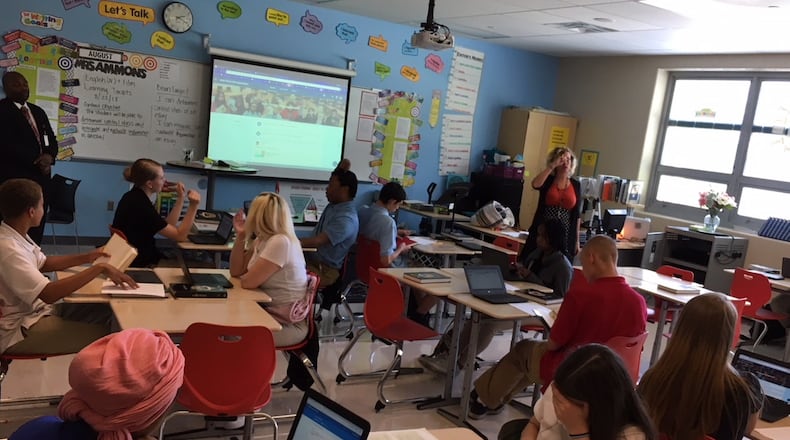In the first year of the plan, Dayton-area districts would receive $31.4 million more than the current year. The plan includes another $25.5 million on top of that in the second year.
RELATED: Bipartisan group aims to reform school funding
Dayton Public Schools would be the only district in the region to see no increase in funding, with Trotwood-Madison and Jefferson Twp. schools getting very small increases. That’s partially because of a change to directly fund charter school and voucher students, rather than having that money pass through the local school districts.
School treasurers and state funding experts were trying to digest the complicated new system Friday, given how some districts rely heavily on state money, while others are largely local-taxpayer funded.
“I’ve been discussing the spreadsheets today with people in Columbus at (the Ohio Department of Education), and they say not to use those numbers, because they’re still in the air,” DPS Treasurer Hiwot Abraha said. “I was worried with our enrollment drop, we might even get less (state funding). … When 74 percent of your revenue is from the state foundation, it is hard to plan.”
The proposal likely will be tweaked as it winds its way through the state legislature the next three months. State Rep. Bob Cupp (R-Lima) said the bipartisan school funding proposal is an attempt to restore fairness, given that 82 percent of local districts currently aren’t funded at the level the state formula says they should be – many of them “capped” too low.
RELATED: Task force studied impact of poverty on schools
“It’s based on what it actually costs to educate students, what taxpayers can afford, and what local school districts determine will work in their communities,” said Cupp, a former Ohio Supreme Court justice who helped build the funding plan. “No district will lose money. And, yes, the plan meets the test of Ohio’s Constitution.”
Cupp and State Rep. John Patterson, (D-Jefferson) built the new funding proposal over 15 months with a team of education and school finance leaders. The last time a true overhaul of the state funding formula was attempted was 10 years ago.
Former state Rep. Stephen Dyer, now the Education Policy Fellow for left-leaning think tank Innovation Ohio, was at the center of that previous effort, and he offered high praise for the current work.
“$718 million more over the biennium is nothing to sneeze at. We’ve needed more money for years,” Dyer said. “They are making a good-faith effort to get to a formula that effectively calculates student need throughout the state. … That is hard and it is complicated.”
RELATED: How does Dayton Public Schools spend its money?
Dyer said the new proposal’s specific funding for mental health services in schools is the first of its kind in the nation. He said there will probably have to be some tweaks in the formula based on how the district-by-district funding shook out in Friday’s spreadsheets.
“But it’s nothing that can’t be done,” Dyer said. “They’re asking the right questions, and they have the right people in the room.”
The projections showed 31 of 37 school districts in the Dayton area getting at least a 4 percent increase in state funding for next school year. All but five of those 31 would get another 4 percent-plus increase the following year.
Other than Dayton, Trotwood and Jefferson, the other districts projected with small increases would be Oakwood, Huber Heights and Valley View. Oakwood would see a 1.6 percent increase in funding for 2019-20 under the plan, then would be the only local district to see a decrease in 2020-21, dropping 1.1 percent.
Some of the projected increases in state funding could be large. Bethel Schools in Miami County would see state funding increase from $4.3 million this year, to $5.8 million next year, and $7.2 million in 2020-21 – a 68 percent rise over two years, according to the plan.
RELATED: How did local schools fare on the state report card?
Beavercreek and Vandalia-Butler schools would see state funding increases of more than 30 percent over two years, and the bump would be more than 40 percent over two years in Kettering, with state aid rising by more than $3 million each year. Each of those districts currently gets most of its annual funding from local levies, with state aid playing a smaller role.
Kettering Treasurer Dan Schall said he’s “cautiously optimistic” about the projections but added that some variables are unknown. He said the fate of Kettering’s $7 million per year in public utility taxes is unclear. Schall said many of the districts projected for major increases are the “capped” districts Cupp referred to.
“If you have been capped, you’re winning big in this (projection),” Schall said. “You’re getting a lot more money because you should have been getting more money to begin with.”
Beavercreek Superintendent Paul Otten said early in the week that he liked the proposed increase in special education funding and eliminating the capped district penalty. The district’s treasurer, Penny Rucker, said it’s too early to grasp exactly how all the moving parts will fit together.
EDUCATION: New graduation rules aimed at Class of 2022
“You go back to Gov. Strickland’s evidence-based model, they didn’t fund it. Kasich tried something else, and they didn’t fund it. This Cupp-Patterson plan reminds me of the Strickland model, but my question is, are they going to fund it?” Rucker said. “Every time they redo the formula, you get big winners and losers. I can’t imagine the urban schools are going to be big losers. That has just never been the case.”
Schall said with the state’s rainy day fund nearing $3 billion, he’s glad that overall education funding would increase, calling it “a reasonable ask.”
Greg Lawson of the right-leaning Buckeye Institute disagreed. He said the system wouldn’t reduce achievement gaps for students in poverty, and he doesn’t think it would be financially sustainable given other spending priorities.
About the Author

